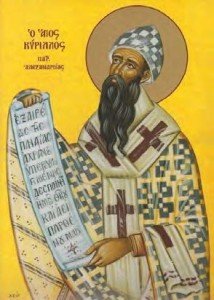In the fifth century, Cyril triumphed over Nestorius using the same process as described in the last issue of this article, that is by using Greek vocabulary as a tool, changing its meaning and making it into a manageable instrument of Christian witness. This can be seen in the famous decree of the Council of Chalcedon (451). Cyril’s Christology has been both kerygmatic and polemical. Eutyches – a zealous, ultra Cyrillian ascetic – interpreted the unity of divinity and humanity of Christ to mean that humanity was so totally “deified” that it ceased to be “our” humanity. Christ was certainly “consubstantial” with the Father, but not “with us.” His humanity was absorbed by God. Eutyches was formally faithful to the Christology of Cyril, but in fact he was depriving it of its meaning for human salvation: God, according to Eutyches, was not sharing human destiny – human birth, suffering and death itself – but, while remaining absolute, changeless and transcendent, was absorbing that human identity which he had originally created. Was he then still the God of love?
The Council of Chalcedon came as a reaction against Eutychianism. But its definition of Christ was a rather elaborate formula which resulted from long debates and was intended to satisfy the different existing terminological traditions: the Alexandrian, the Antiochene and the Latin. The latter expressed itself in the powerful intervention of Pope Leo the Great in his letter to Flavian of Constantinople. In this famous text, the pope, using a terminology inherited from Tertullian and Augustine, carefully established the integrity of the two natures of Christ, and insisted that this integrity requires that each nature preserve fully its characteristics. This resulted in the Council of Chalcedon issuing this text:
Following the holy Fathers, we all with one voice confess our Lord Jesus Christ one and the same Son, the same perfect in Godhead, the same perfect in humanity, truly
God, truly man, the same consisting of a reasonable soul and a body, of one substance with the Father as touching the Godhead, the same of one substance with us as touching humanity, like us in all things apart from sin.
While I will continue to share more of this statement from the Council, I would truly encourage all to study this beginning part since it is THE TRUE STATEMENT of our belief about Who Jesus is. Although it may sound technical, it is the exact statement of the Council which is the foundation of our faith. It means that Jesus is TRULY GOD and TRULY MAN.

